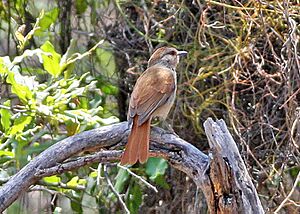Rufous-tailed palm thrush facts for kids
Quick facts for kids Rufous-tailed palm thrush |
|
|---|---|
 |
|
| Conservation status | |
| Scientific classification | |
| Genus: |
Cichladusa
|
| Species: |
ruficauda
|
| Synonyms | |
|
Bradyornis ruficauda |
|
The rufous-tailed palm thrush (Cichladusa ruficauda) is a type of bird that belongs to the Muscicapidae family. This family includes many small, insect-eating birds, often called Old World flycatchers. This bird gets its name from its reddish-brown tail and its habit of living near palm trees.
Contents
About the Rufous-tailed Palm Thrush
This bird was first described by a scientist named Hartlaub in 1857. It was given the scientific name Bradyornis ruficauda back then. Today, it is known as Cichladusa ruficauda. This bird is considered "monotypic," which means it is the only type of its species. There are no different subspecies or variations of it.
Where Does This Bird Live?
The rufous-tailed palm thrush lives in several countries in Africa. You can find it in Angola, the Central African Republic, the Republic of the Congo, the Democratic Republic of the Congo, Equatorial Guinea, Gabon, and Namibia.
What Kind of Places Does It Like?
This bird's home, or habitat, covers a very large area, about 1,700,000 square kilometers (656,000 square miles). It prefers to live in areas with palm trees, dry forests, and new forests that have grown back after old ones were cut down. It often lives near rivers or along the coast. You can find it in places up to 1,200 meters (about 3,900 feet) high. Sometimes, it even lives in banana farms and gardens.
What Does the Rufous-tailed Palm Thrush Look Like?
This bird is about 17 to 18 centimeters (6.7 to 7.1 inches) long. It weighs between 22 and 37 grams (0.8 to 1.3 ounces). Male and female birds look very similar.
Colors and Features
The top of its head and the back of its neck are a bright reddish-brown color. Its back and shoulders are also reddish-brown, but a bit lighter. The main feathers used for flying are dark brown with reddish edges. The feathers under its wings are a pale brownish-yellow. Its lower back and tail are reddish-brown or chestnut colored.
The bird's face and sides of its neck are mostly light gray. The area between its eyes and beak, called the lores, is darker. Its chin, throat, and upper chest are yellowish-buff. The rest of its chest and sides are light gray, and the middle of its belly is a pale yellowish color.
Its eyes can be brown or red. The beak is black. Its legs can be light brown, light purple, or bluish-gray.
Young Birds
Young rufous-tailed palm thrushes look a little different. They have dark streaks on their head and neck. They also have dark bars on their back. Their underside is mostly grayish with dark spots.
Behavior and Life Cycle
The rufous-tailed palm thrush is a shy bird. It is usually seen in pairs or small groups.
Sounds and Songs
When this bird feels scared, it makes a "churr" sound. Its song is very special. It usually sings at sunrise or sunset. The song is a series of loud, beautiful whistles mixed with babbling and chattering sounds. Sometimes, a pair of birds will sing together, creating a duet.
What Do They Eat?
This bird looks for food on the ground. It mainly eats adult beetles and their young (larvae). It also enjoys spiders and fruits.
Reproduction and Nesting
Rufous-tailed palm thrushes have been seen breeding from August to April. They are monogamous, meaning a male and female bird stay together for breeding.
The nest is shaped like a deep, thick cup. It is made of mud and lined with grass and plant fibers. They often build their nests at the bottom of a palm leaf or in a crack in a tree trunk. Sometimes, they choose other spots too. A female bird usually lays one to four eggs. The eggs are pale greenish with light freckles.
This bird does not migrate, meaning it stays in the same area all year round.
How Is This Bird Doing?
We don't know exactly how many rufous-tailed palm thrushes there are in the world. However, this bird lives in a very large area. Its population seems to be stable, meaning it's not going down. Also, there are no major threats to this species. Because of these reasons, the IUCN Red List has listed the rufous-tailed palm thrush as a species of "least concern." This means it is not currently at risk of disappearing.
Images for kids



